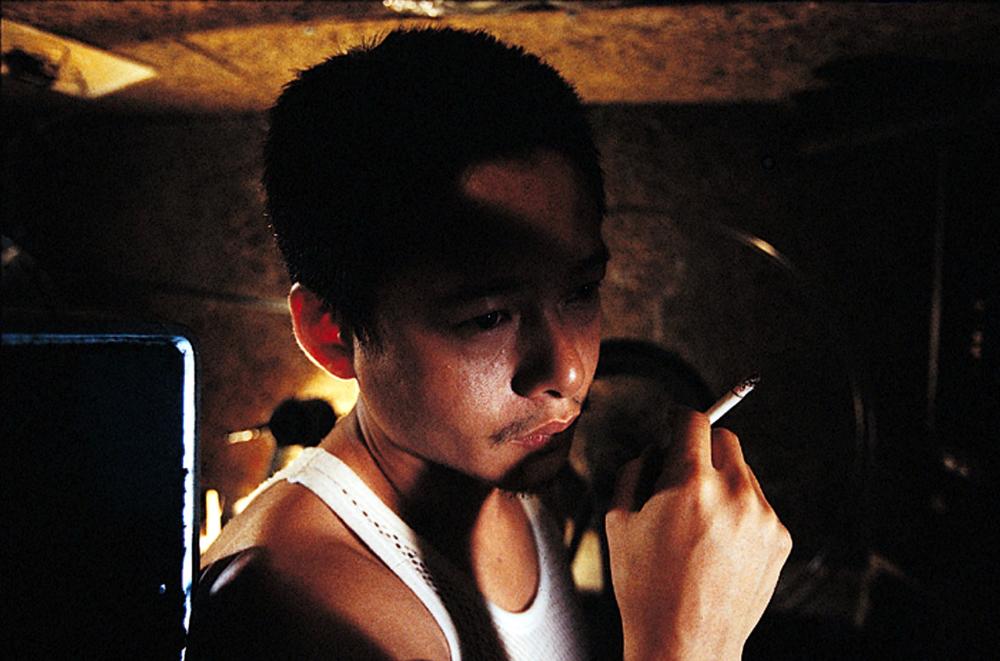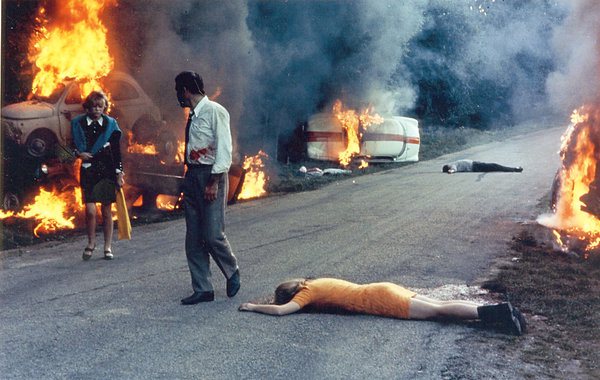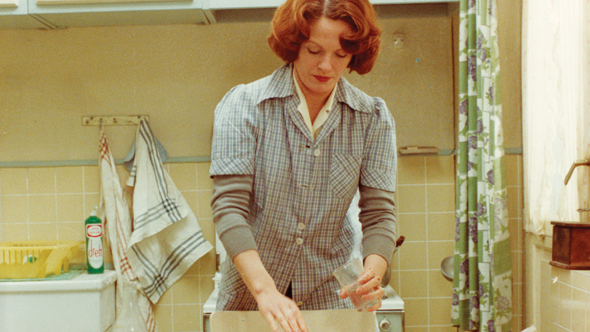4. Satantango (Bèla Tarr, 1994) – Opening scene

In specific cinephile circles, the movies of Bèla Tarr are famous for making Italian Neorealism look like a Baz Luhrmann movie in comparison to his movies. His black and white cinematography goes hand in hand with the bleak, grim surroundings of his movies and ultimately shows a society in deepest poverty and hopelessness. The constant rain that dominates the sound in most of the scenes during his 7-hour epic Satantango only adds up to this premise.
Even the opening scene is a warn-signal for impatient viewers : In an uninterrupted 8 minute tracking shot, the camera of Gábor Medvigy floats over a herd of cows, slightly distant from the viewer while the score of Milhály Vig fills the scenery with unspoken tension. We are thrown in a setting in which humanity not only has died a long time ago, but has never existed in the first place. It is the perfect opening for Tarr`s film because it will drawn in viewers who are ready to take the task of watching this movie and already alienate those who would have never endured the movies running time in the first place.
3. Goodbye, Dragon Inn (Tsai Ming-liang, 2004) – After the Screening

There are many love-letters to cinema and Tsai Ming-Liang’s Goodbye, Dragon Inn certainly is one of them. But foremost, as the title indicates, it is a goodbye-letter to cinema. It is a film that breathes in his setting : An old Taipei movie theatre that has its last screening of King Hus classic Samurai-epic Dragon Inn before being closed down for good. Liang follows several individuals who are involved in the cinema like the projectionist, the cleaning staff and of course the movie goers. Goodbye, Dragon Inn is a melancholic meditation on the end of classic movie-going experience that comes out almost completely without dialogue.
In one of the last scenes of the movie, after the movie aired, we see the, now empty, cinema hall one last time. It is a shot that lasts for about 5 minutes and the only moving object that is observable within it, is a man cleaning the seat-rows. The moment is drawn out on purpose as if the camera does not want to leave this place. Liang does not want to let this “last” moment of cinema to pass but also reflects tells us that the seats will now remain empty forever. It is a bittersweet moment for everyone, who ever felt passionate about Cinema.
2. Weekend (Jean-Luc Godard, 1967) – Traffic Jam

Weekend by Jean-Luc Godard is, to say the least, a daunting film. It´s a movie with the ambition to disrupt cinema and its conventions fundamentally by permanently making you aware of its fictitious nature and with characters, who seem to know that they are in a movie. The movie features scenes that only seem to the purpose to annoy you as a viewer. The conclude it, there are not many movies that show this much apathy for it´s audience, like Weekend does.
This concept is highlighted in an infamous, nearly 8 minutes long, unbroken tracking-shot of a traffic-jam. The scene seems to serve no direct purpose except maybe to alienate as many viewers as it can. The audio during this scene is filled with the never-ending, disrupting sounds of car-honks that penetrate every ear-drum.
As the scene progresses, the scenario of multiple cars being stuck on a highway becomes weirder until it ends with a gut-punch to all the participants who endured this challenging, cinematic moment, by revealing the cause of the jam : The horrific car-accident of a family, whose bodies are now lying dead on the streets.
While the scene is hard to endure, it is recommended to be watched multiple times to spot all the many details Godard included in it. The scene itself, like the movie Weekend as a whole, might be an attempt to destroy cinema, but its actually a testament to the power of cinema and how it can generate emotions like rage and frustration.
1. Jeanne Dielman – 23 quai du Commerce, 1080 Bruxelles (Chantal Akerman, 1975) – The whole movie

This is a bit of a cheat-entry. There are many scenes in Chantal Akermans 1975 masterpiece Jeanne Dielman that differ from one another. However, picking just one of them would serve no purpose in explaining the haunting nature of this movie and the aggressive social commentary it provides.
Jeanne Dielman follows the titular character, a housewife who makes a living through prostitution, for three days, chronicling nearly every step of her daily routine. Her actions are precise, almost too precise for our viewing experience. We observe her preparing dinner for her son, cleaning the apartment she lives in, taking care of her neighbors baby. Scenes like these seem to have no entertaining or story-telling value, they are all scenes that would have been erased from any other movie in the editing process. But Jeanne Dielman only consists of scenes like that and this makes the 200-minute running time even harder to endure.
Adding to this, we never get to know Jeanne Dielman as a character, since Akerman never gives us a glimpse into her state of mind. In a very long scene, we see Jeanne Dielman sitting in a restaurant, staring into something the permanently static camera does not show. At first, we wonder what she is seeing, but then we wonder if she sees anything at all.
Akerman keeps the viewer captive in a life that seems completely empty and by thus creates a powerful image of an anonymous society. Jeanne Dielman can be read as a feminist movie that tries to bring the attention of male-viewers to the mundane daily-routine of a housewife, an integral part of their lives that is taken for granted. This makes Jeanne Dielman one of the most radical movie experiments and it is often referred to as the best movie directed by a female director ever.
Author Bio: Jakob is a cinephile living in Germany. He recently started to study American Studies and German Literature.